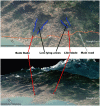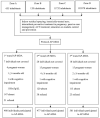Mass Drug Administration With Artemisinin-Piperaquine for the Elimination of Residual Foci of Malaria in São Tomé Island
- PMID: 34322498
- PMCID: PMC8311023
- DOI: 10.3389/fmed.2021.617195
Mass Drug Administration With Artemisinin-Piperaquine for the Elimination of Residual Foci of Malaria in São Tomé Island
Abstract
Background: Mass drug administration with artemisinin-piperaquine (AP-MDA) is being considered for elimination of residual foci of malaria in Democratic Republic of São Tomé and Principe. Methods: Three monthly rounds of AP-MDA were implemented from July to October 2019. Four zones were selected. A and B were selected as a study site and a control site, respectively. C and D were located within 1.5 and 1.5 km away from the study site, respectively. Parasite prevalence, malaria incidence, and the proportion of the Plasmodium falciparum malaria cases were evaluated. Results: After 3 monthly rounds of AP-MDA, the parasite prevalence and the gametocyte carriage rate of P. falciparum in zone A decreased from 28.29(‰) to 0 and 4.99(‰) to 0, respectively. Compared to zone B, the relative risk for the population with Plasmodium falciparum malaria in zone A was lower (RR = 0.458, 95% CI: 0.146-1.437). Malaria incidence fell from 290.49(‰) (the same period of the previous year) to 15.27(‰) (from the 29th week in 2019 to the 14th week in 2020), a decrease of 94.74% in zone A, and from 31.74 to 5.46(‰), a decline of 82.80% in zone B. Compared to the data of the same period the previous year, the cumulative number of P. falciparum malaria cases were lower, decreasing from 165 to 10 in zone A and from 17 to 4 in zone B. The proportion of the P. falciparum malaria cases on the total malaria cases of the country decreased of 90.16% in zone A and 71.34% in zone C. Conclusion: AP-MDA greatly curbed malaria transmission by reducing malaria incidence in the study site and simultaneously creating a knock-on effect of malaria control within 1.5 km of the study site and within the limited time interval of 38 weeks.
Keywords: P. falciparum; artemisinin-piperaquine; elimination; malaria foci; mass drug administration.
Copyright © 2021 Li, Tuo, Tan, Zhang, Zheng, Wang, Xu, Yu, Lu, Wu, Huang, Rampao, D'almeida, Yan, Song, Guo and Deng.
Conflict of interest statement
The authors declare that the research was conducted in the absence of any commercial or financial relationships that could be construed as a potential conflict of interest.
Figures
References
-
- World Health Organization [WHO] . World Malaria Report 2018 (2018). Geneva: WHO.
-
- World Health Organization [WHO] . World Malaria Report 2019 (2019). Geneva: WHO.
-
- Ministério da Saúde [MS] . PROTOCOLO PARA O MANEJO DE CASOS DE PALUDISMO. S. TOME E PRÍNCIPE: MS; (2018).
-
- World Health Organization [WHO] . Terminology of Malaria and of Malaria Eradication. Geneva: WHO; (1963).
-
- World Health Organization [WHO] . Guidelines on the Elimination of Residual Foci of Malaria Transmission. Geneva: WHO; (2007).
LinkOut - more resources
Full Text Sources





